IBM PC/XT
Introduction
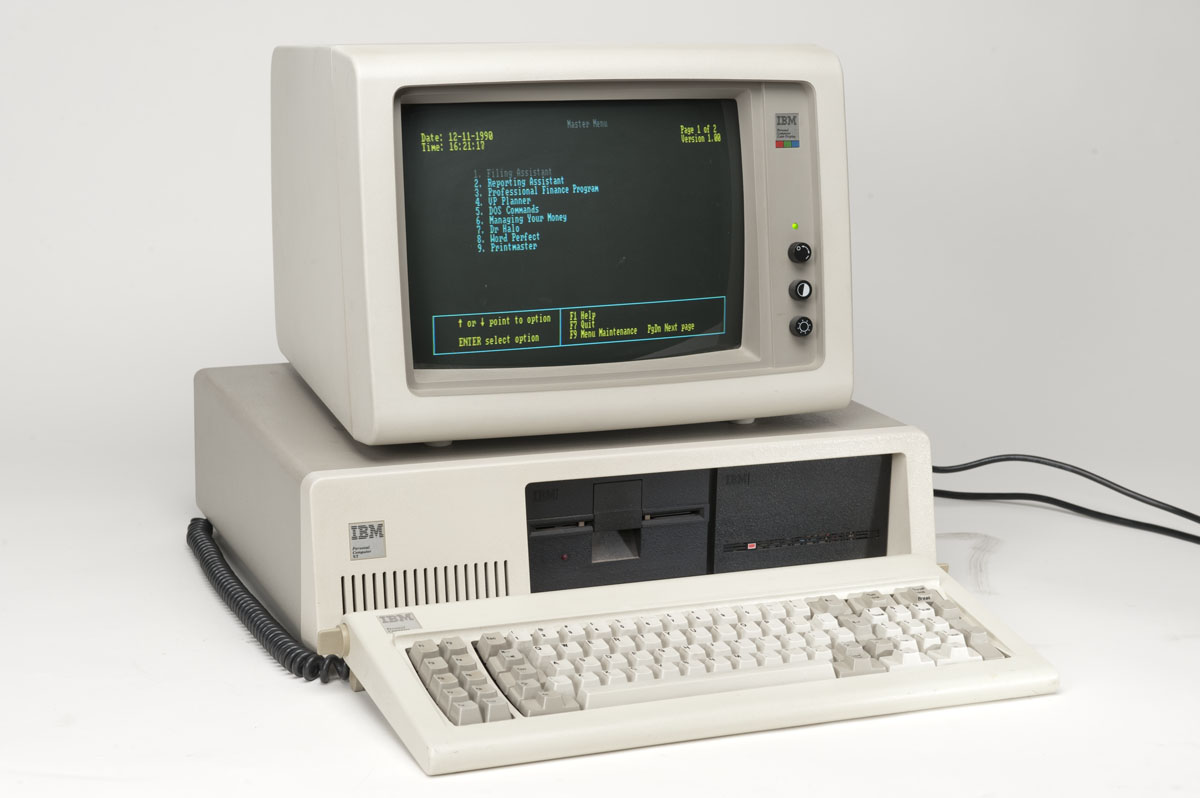 Following IBM's successes with the IBM PC, they introduced the XT ("eXtended Technology") version with a built-in hard disk on 8th March 1983. It was primarily aimed at business users - the base specification was a 10 MB Seagate ST-412 hard disk, 128 KB RAM (soon to be made 256 KB), 5.25" 360 KB floppy disk drive, serial port card and 130W power supply.
Following IBM's successes with the IBM PC, they introduced the XT ("eXtended Technology") version with a built-in hard disk on 8th March 1983. It was primarily aimed at business users - the base specification was a 10 MB Seagate ST-412 hard disk, 128 KB RAM (soon to be made 256 KB), 5.25" 360 KB floppy disk drive, serial port card and 130W power supply.
Two years later, floppy-only versions of the XT would eventually replace the original model 5150 PC.
A further enhancement over the original PC was an increase in expansion slots from 5 to 8. IBM had realised soon after the Model 5150 was launched that most users would have to use two of these for a display card and floppy disk controller card, leaving just 3 for other purposes. With the XT design they would potentially have 6 free after the display card and floppy/hard disk controller card. the XT dropped the cassette port, but still contained "Cassette BASIC" in ROM.
Early designs for the new IBM PC-XT showed that it might be based on the newer Intel 80186 microprocessor, but IBM ultimately decided to keep the motherboard specs the same as the IBM PC, still running an Intel 8088 microprocessor at 4.77 MHz. It also retained the same 8087 math coprocessor socket. Because the hard disk took up two of the four drive bays (the hard disk was what we now refer to as "full height"), and the floppy drives provided by IBM at the time were also full height, any user who wanted two floppy drives in addition to the hard disk had to purchase the Model 5161 Expansion Chassis, which actually meant effectively buying two hard disks as the Expansion Chassis came with one as standard.
Unlike many hard disk systems on microcomputers at the time, the XT was able to boot directly off the drive and did not require a boot floppy.
It was discontinued in the Spring of 1987.
Model Variants
The following models were available to purchase:-
Model 5160, 128 KB RAM, no floppy drives, no monitor = $ USD.
Model 5160, 256 KB RAM, single 5.25" floppy drive, monochrome monitor = $ USD.
Model 5160, 128 KB RAM, single 5.25" floppy drive, colour CGA monitor = $ USD.
Model 5160, 256 KB RAM, single 5.25" floppy drive, colour CGA monitor = $ USD.
With the maximum amount of 256 KB RAM and colour graphics the total cost would hit $6,000 USD.
A Model 5150 with a single floppy drive and monochrome monitor in the UK retailed at £1,736 GBP.
Supplied Software
Just as with the original IBM PC, no software was supplied bundled with the XT.
Expansion / Compatibility
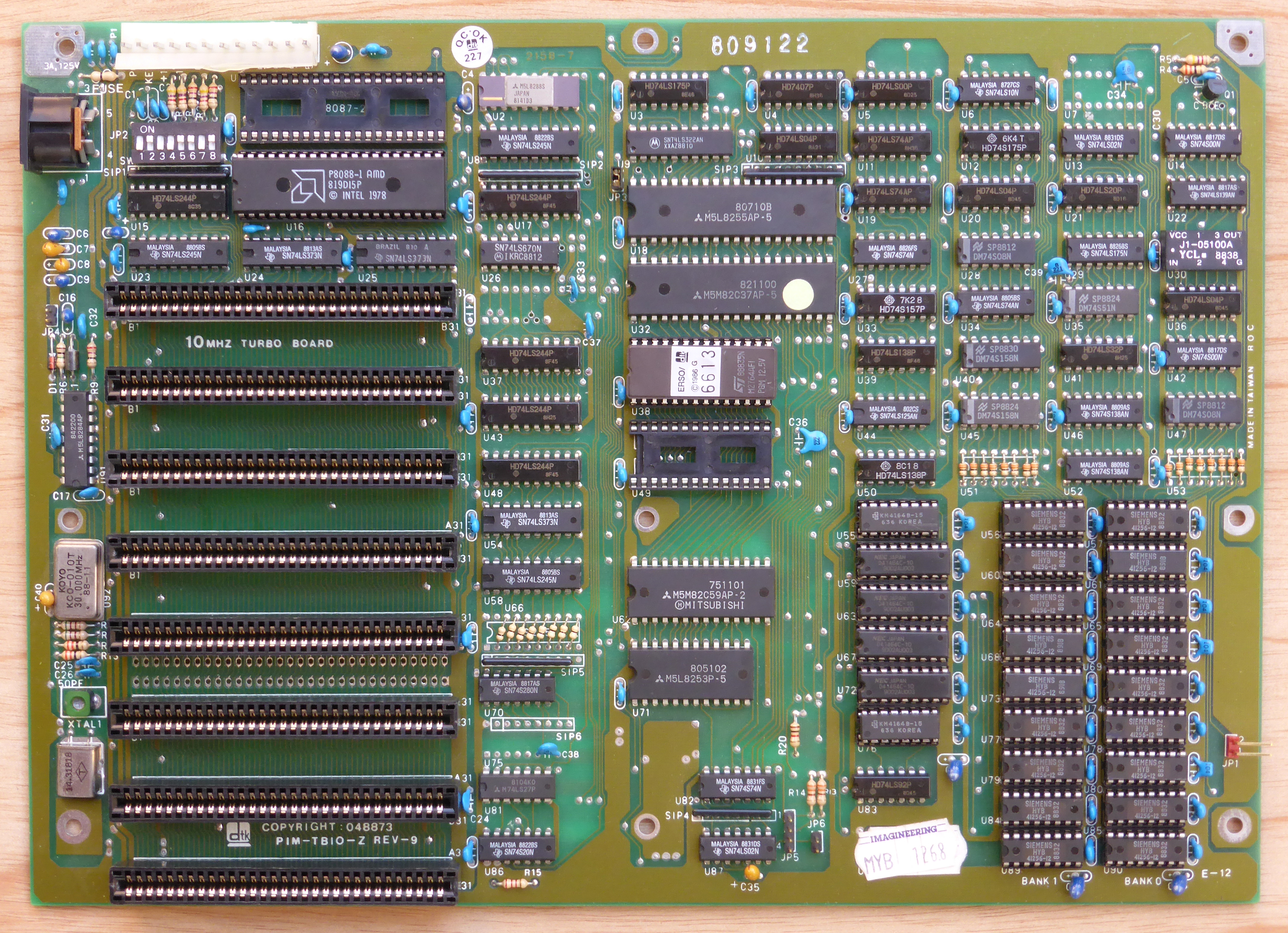 The XT retained the same expansion bus as the PC - this would later be called 8-bit "Industry Standard Architecture", or "ISA" bus. Two of the expansion slots sit behind the left-hand floppy drive, so can only support shorter cards than the other six. Most PC cards would not fit into the two short slots, and some would not even fit into the six standard-length slots because on the XT the slots were placed closer together. It was rare to have a card that couldn't fit beside others, but they did exist. This narrower spacing meant that an XT (5160) motherboard would not fit into a PC (5150) case.
The XT retained the same expansion bus as the PC - this would later be called 8-bit "Industry Standard Architecture", or "ISA" bus. Two of the expansion slots sit behind the left-hand floppy drive, so can only support shorter cards than the other six. Most PC cards would not fit into the two short slots, and some would not even fit into the six standard-length slots because on the XT the slots were placed closer together. It was rare to have a card that couldn't fit beside others, but they did exist. This narrower spacing meant that an XT (5160) motherboard would not fit into a PC (5150) case.
The floppy and hard drive adapters, the serial port card, and nearly always a display adapter board occupied slots.
Slot 8
On the IBM PC/XT, the eighth slot (closest to the power supply) is different from the others. Unlike the other seven slots, it is expected to respond with a 'card selected' signal whenever the card is selected. Basically, what this means is that cards inserted into this slot need to be 'Slot 8' compatible in order to guarantee 100% proper operation. Some cards won't work at all. It was designed to be used initially with the IBM Asynchronous Serial Card.
Back when this machine was popular, some expansion card manufacturers specifically called out the fact that the card should be installed in any available slot apart from slot 8. Cards of the era often came with a 'slot 8' jumper fitted, so that the user could set the jumper if the card was installed in slot 8, or unset if installed in another slot.
BIOS / RTC
The XT BIOS is in two separate chips on the motherboard. One is in socket U18 and the second is in socket U19. There were 4 revisions of the BIOS, differentiated only by date (no version number). Date formats are always MM/DD/YY. They were:
- IBM Part #5000026 (in U18) and #5000027 (in U19) - dated 08/16/82. Supports 360 KB floppy drives.
- IBM Part #1501512 (in U18) and #5000027 (in U19) or #1501512 (in U18) and #6359116 (in U19) - dated 11/08/82. Supports 360 KB floppy drives, with partial 720 KB support (requires DRIVER.SYS to be loaded using DEVICE=C:\DOS\DRIVER.SYS /D:0 /F:2 to successfully format a 720 KB disk).
- IBM Part #62X0851 (in U18) and #62X0854 (in U19) - dated 01/10/86. Supports 360 KB, 720 KB, and 1.2 MB floppy drives. Note that whilst 1.2 MB drives are supported by the BIOS, the supplied floppy controler in the XT does not support high-density drives.
- IBM Part #62X0890 (in U18) and #68X4370 (in U19) - dated 05/09/86. Sames as previous version, One known problem with this BIOS version is that some third-party floppy controllers fail to boot a known-good 1.44 MB floppy disk.
Just as with the original IBM PC, the XT did not come with a real-time clock onboard. Instead owners would need to purchase an expansion card that provided this convenience. Some memory expansion cards came with this.
Monitors / Graphics
The same two display choices were available for the XT as for the earlier PC from IBM: Monochrome or CGA colour. The CGA video card came with 16 KB of video RAM onboard and allowed display output to either an NTSC television with an appropriate modulator, or to an RGB monitor such as IBM's own Model 5153. With the monochrome option, the XT incorporated an MDA display card (which also had an onboard parallel printer port) and an IBM Model 5151 monochrome monitor. This could display 80x25 characters on the 11.5" screen, and supported underlining, high-intensity blinking characters and reverse image for highlighting. It has brightness and contrast controls built-in. Both an MDA and CGA card could work in the machine at the same time, driving two separate monitors. Some application software like Lotus 1-2-3 and AutoCAD supported this feature. In 1984, upon launch of the IBM PC/AT, IBM also released an EGA solution for the IBM PC and XT, which comprised the Model 5154 Enhanced Graphics Display and the Enhanced Graphics Adapter. The display alone had an MSRP of $849 USD. At the same time they also released the PGC (Professional Graphics Controller), also known as PGA (Professional Graphics Adapter) - this was aimed at CAD and other professional business software, as it provided resolutions up to 640 x 480 in 256 colours. The card was almost an entire computer in its own right, with its own dedicated Intel 8088 CPU and 320 KB of RAM.
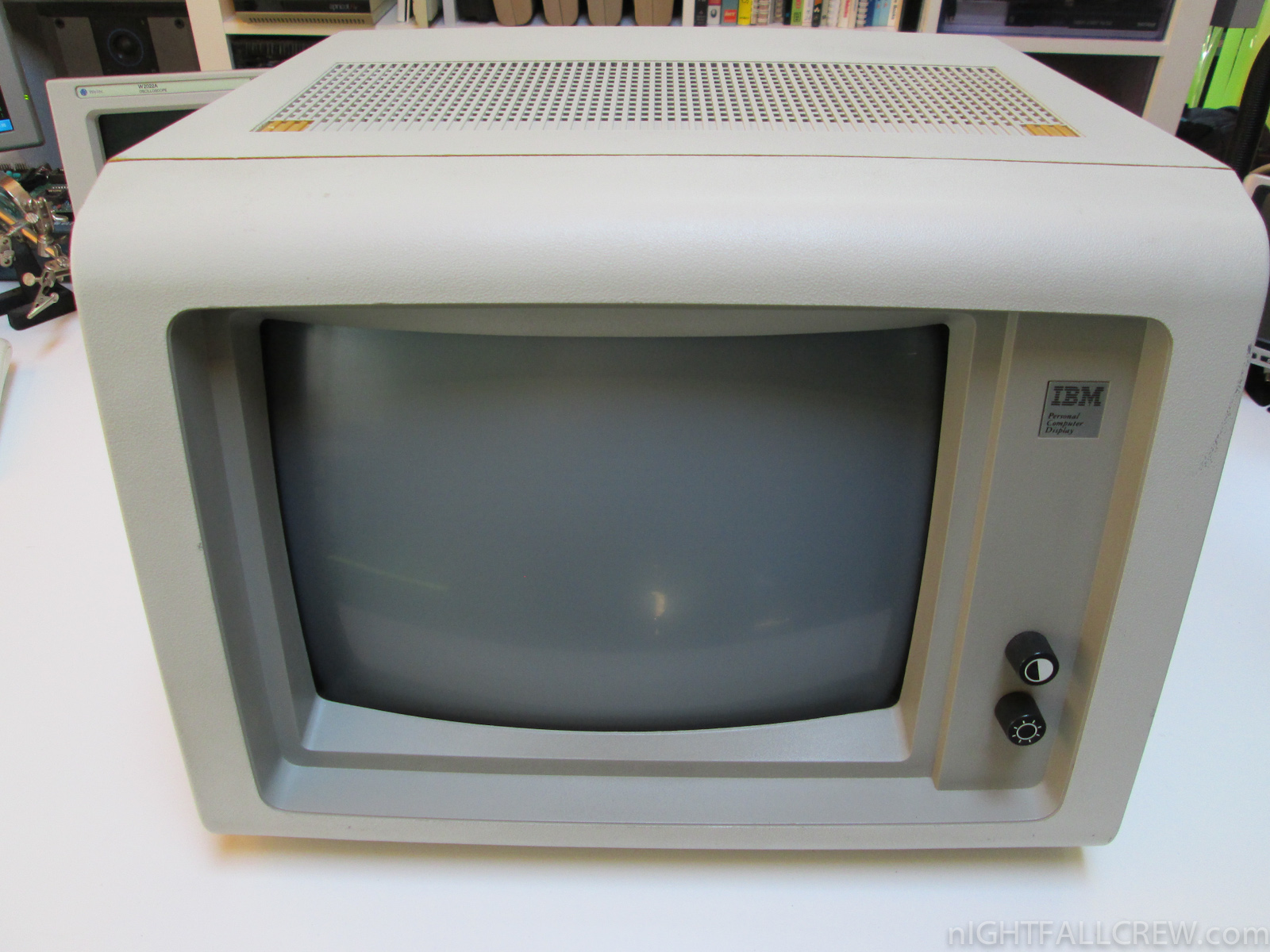
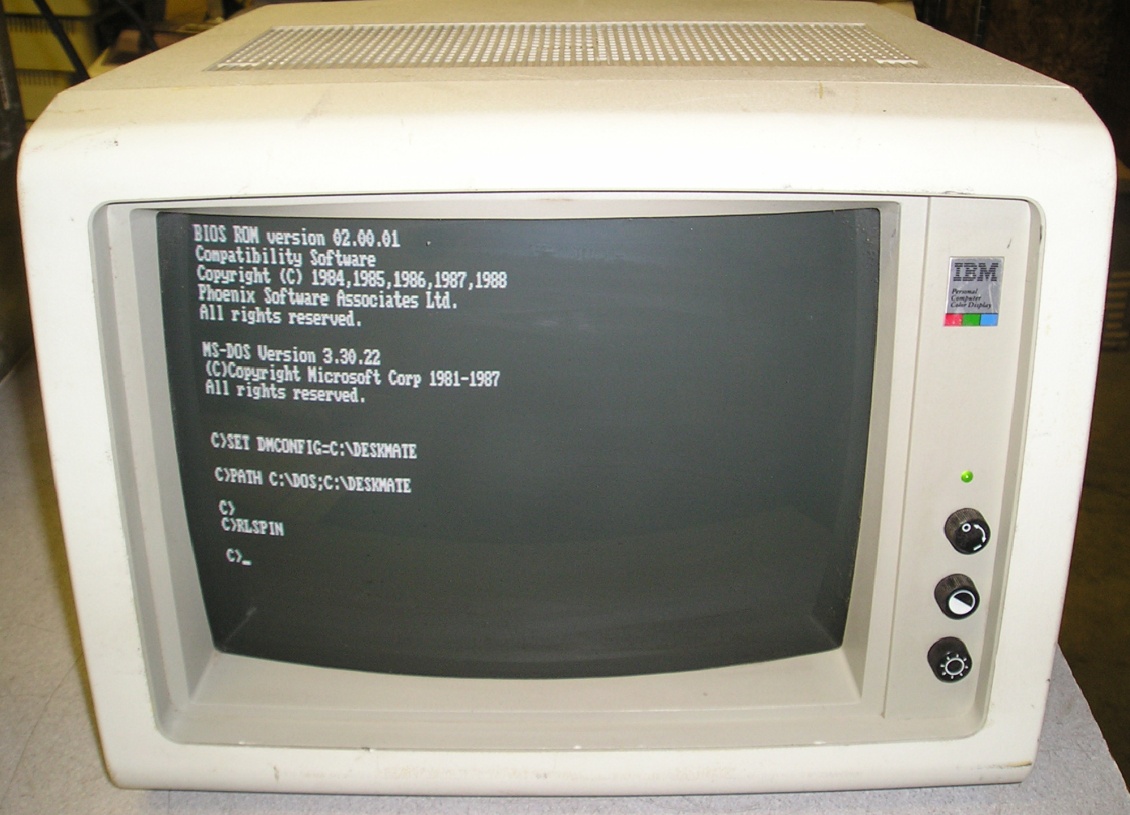
Upgrading an XT to EGA or VGA graphics today can be hit and miss. Here are some points:
- Some graphics cards look "16-bit", but the small 16-bit header is not connected.
- Some 16-bit cards have a jumper to allow them to work in an 8-bit PC, although sometimes this means an 8-bit slot in an AT-class computer, and will not work in the 5160.
- Replacing the Intel 8088 with an NEC V20 can make some previously incompatible VGA cards work just fine.
Some cards that are known to work in an XT are:
AST VGA,
AST VGA Plus,
Hercules GB500,
IBM PS/2 Display Adapter,
Micro Labs Ultimate VGA,
Oak OTI-037C,
Oak VGA-K077,
STB Systems VGA 640, Video Seven VEGA VGA,
Video Seven VGA-16,
Video Seven VGA 16E,
Video Seven VGA 1024i, Video Seven V-RAM VGA,
Wang 3050,
WD Paradise VGA Professional
Keyboard / Mouse
On the back of the XT is a single 5-pin DIN plug for the keyboard (the little-used cassette port on the Model 5150 was omitted on the 5160). The IBM "Model F" keyboard, with 83 keys, is the same as the one supplied with the PC Model 5150. Both the PC and XT used what is now referred to as the "XT protocol". The later IBM PC/AT (Model 5170) would change this to a new "AT protocol" which used different signalling, so a PC/XT keyboard is not usable on more modern computers and vice-versa.
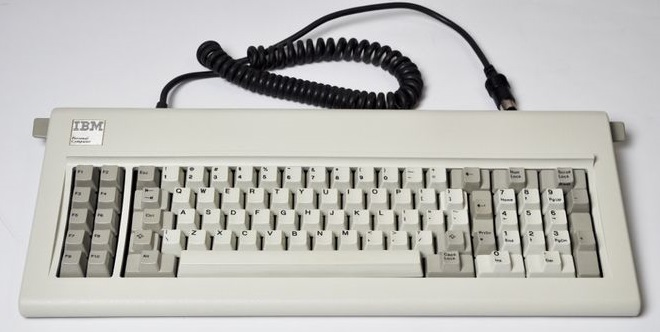
Floppy Disk Drives
For the XT IBM discontinued the cassette port option found on the original IBM PC as the market for commercial products being distributed on cassette never materialized - most had chosen at least one floppy drive for their system.
/images/ibm_pc_360K_floppy_drive.jpg) With two floppy drives a user would typically run the 'Program' disk in Drive A: and store their working files on a disk in Drive B:. These floppy drives supported disks that could hold up to 160 KB. Both double-sided and single-sided floppy drives were available (where the user would be required to turn the floppy disk over to write on the other side).
With two floppy drives a user would typically run the 'Program' disk in Drive A: and store their working files on a disk in Drive B:. These floppy drives supported disks that could hold up to 160 KB. Both double-sided and single-sided floppy drives were available (where the user would be required to turn the floppy disk over to write on the other side).
The floppy disk controller card that came with the IBM XT does not support high-density (1.2 MB and 1.44 MB) drives, although later on in the XT's lifespan IBM did add support to the BIOS (2nd and 3rd versions) for 1.2 MB drives. Despite this, they never offered a floppy controller card that supported them. 1.44 MB drives were never supported but if you connect one of these to your IBM controller it will be interpreted as 720 KB, and you can read and write to the disks but not format.
Hard Disks
The XT came as standard with a Seagate ST-412 hard disk which had a total capacity of 10 MB. In order for the motherboard to communicate with this, a Xebec 1210 ST-506 compatible controller was also included and took up one of the 8 expansion slots. Later versions of the XT came with a 20 MB hard disk, which also required an upgrade to IBM DOS 3.30. In order to have enough power for an internal hard disk the XT's power supply was a whopping 157W (the Model 5150's by comparison was just 63.5W).
Memory
The maximum amount of memory supported by the IBM XT was 640 KB, achievable through the installation of 256 KB on the motherboard (using 64 Kbit DRAM chips). Later models allowed for all 640 KB to be installed directly on the motherboard. The remaining 384 KB of address space accessible by the Intel 8088 (between 640 KB and 1 MB) was used for the BIOS ROM, adapter ROM and video RAM space.
CPU
The Model 5160 came with the Intel 8088 microprocessor, which ran at 4.77 MHz. Some owners replaced the 8088 with an NEC V20 for a slight increase in processing speed and support for real mode 80186 instructions. The V20 gained its speed increase through the use of a hardware multiplier which the 8088 lacked. An Intel 8087 math coprocessor could also be added for hardware floating-point arithmetic.
Operating System
The IBM PC Model 5160 is capable of running DOS versions from 1.0 right up to 6.22 - the default version on release was IBM PC DOS 2.0.
IBM PC DOS 7.00 / 2000 runs fine, as will Novell / Caldera / DR-DOS 7.0x.
MS-DOS 7.0/7.1 is for 32-bit machines only - it requires at least a 386 to run.
It's worth bearing in mind however, that later DOS versions tended to use up more conventional memory, not to mention that the original disks are often 3.5" 1.44 MB in capacity, so you will need to create your own boot disks to work on the older drive.
FAQ
Q: Can I fit half-height drives to an XT?
A: The XT's chassis doesn't have screw holes for the 'upper' drive. Some XTs that were sold after the introduction of the AT had half-height 5.25" 360 KB floppy drives similar to those shipped with the AT. These used special metal adapter brackets that basically join the two drives together (a kit was available from IBM for this). Later 5160s got an extra screw hole in the bottom of the case to secure the two-drive bracket to the case. Click here for a picture of one side of the bracket.
Physical Attributes
| Item | Dimensions (mm) | Weight (kg) |
|---|---|---|
| System unit | 20" (w) x 16" (d) x 5.5" (h) | 21 lbs (no disk drives), 25 lbs (one drive), 28 lbs (two drives) |
| Keyboard unit | 20" (w) x 8" (d) x 2" (h) | 6 lbs |
| Matrix printer | 16" (w) x 15" (d) x 4" (h) | 12.5 lbs |
| Monochrome display | 15" (w) x 14" (d) x 11" (h) | 17 lbs |
| Colour display | 372(w) x 365(d) x 330(h) | 11.6 |
Here's an information pamphlet for the IBM range of computers. Click on each image for a larger version:
/adverts/Pamphlet/ibm1.jpg)
/adverts/Pamphlet/ibm2.jpg)
/adverts/Pamphlet/ibm3.jpg)
/adverts/Pamphlet/ibm4.jpg)
/adverts/Pamphlet/ibm5.jpg)
/adverts/Pamphlet/ibm6.jpg)
/adverts/Pamphlet/ibm7.jpg)